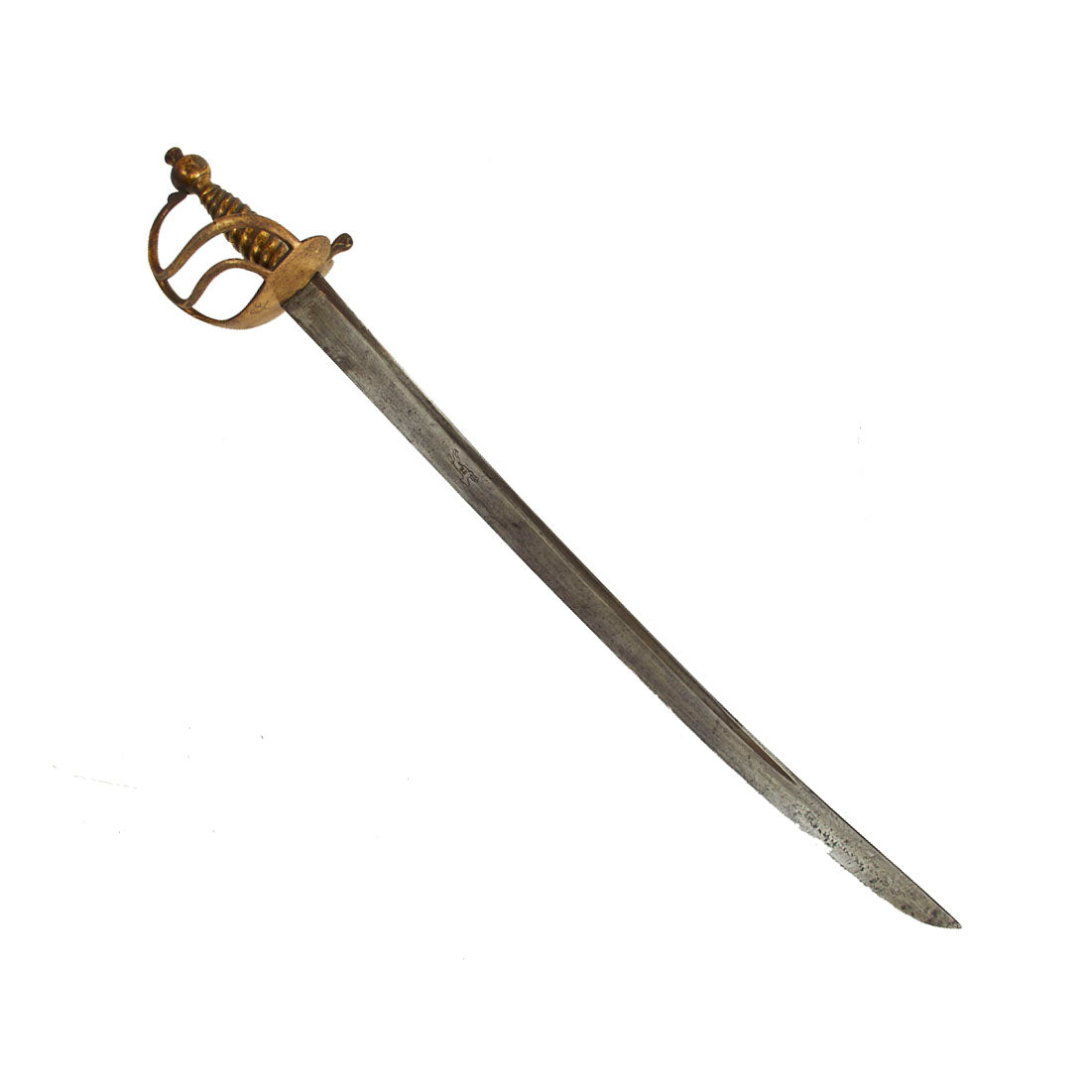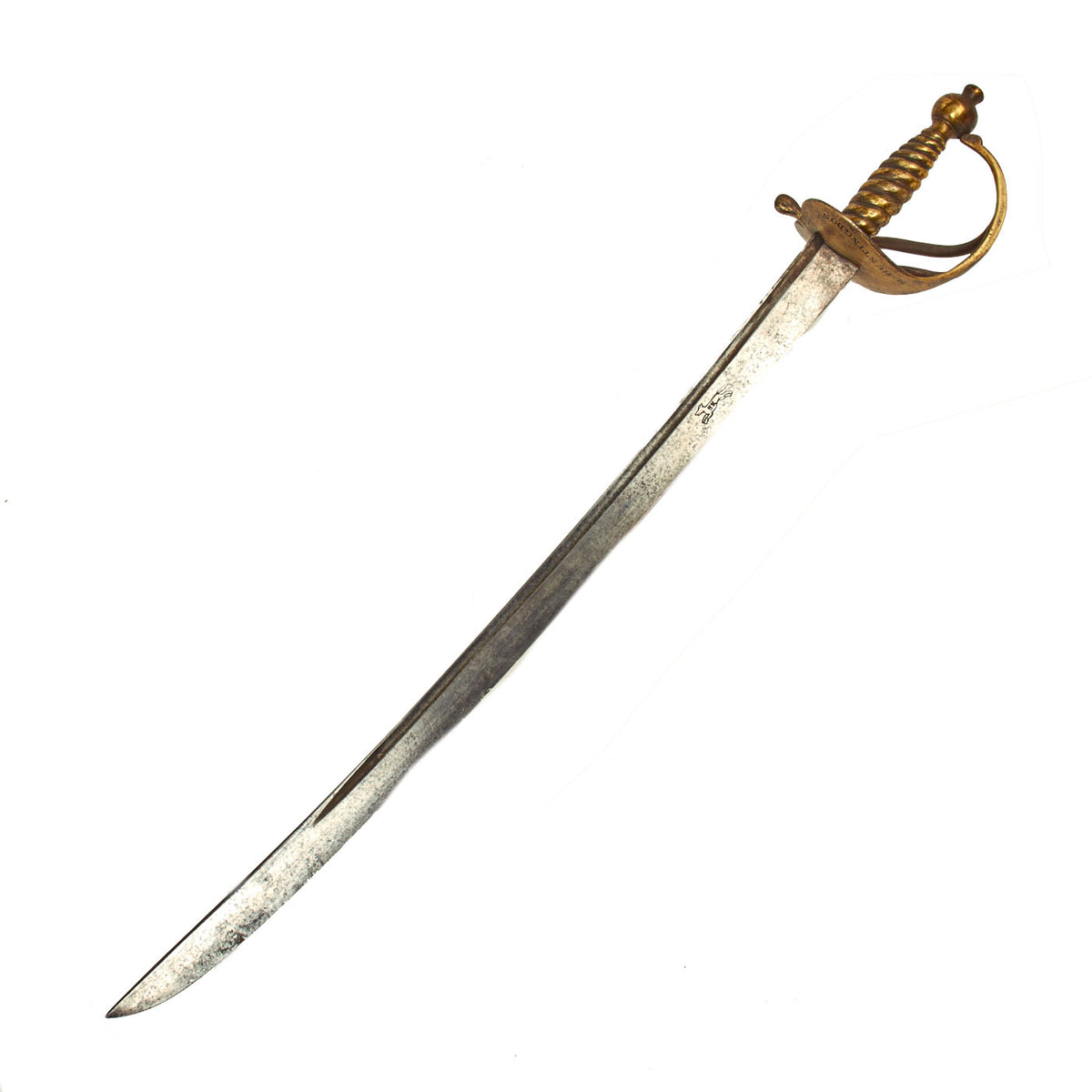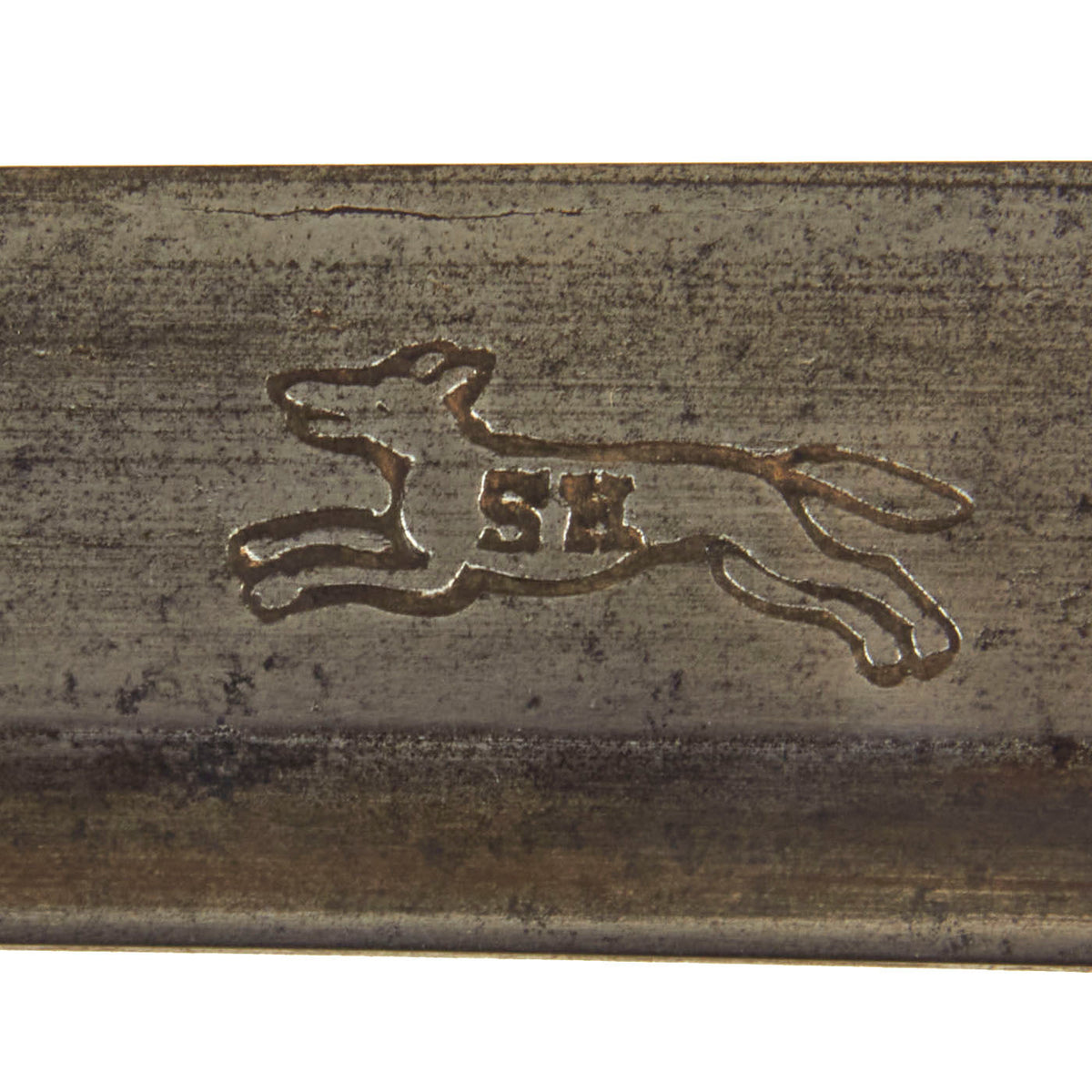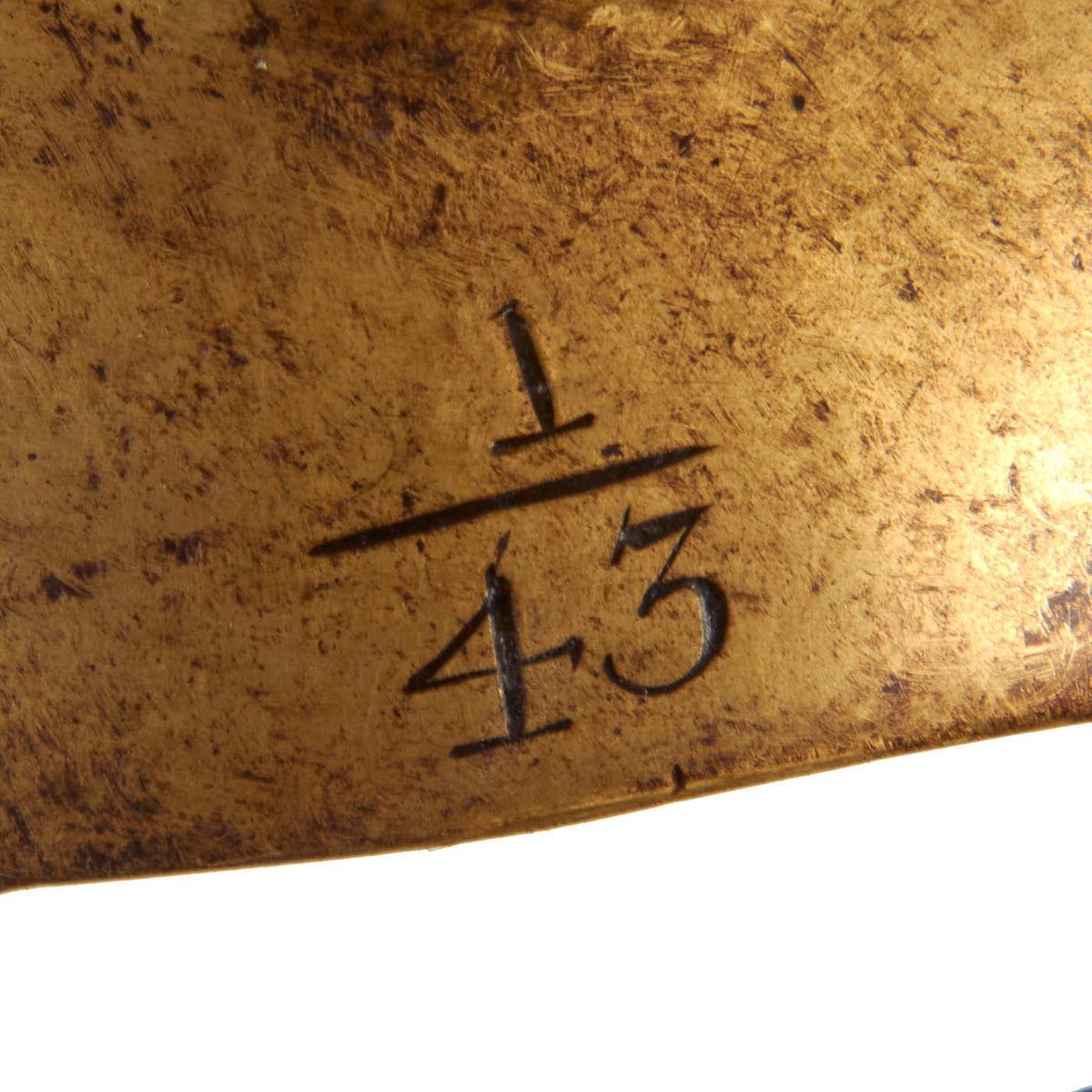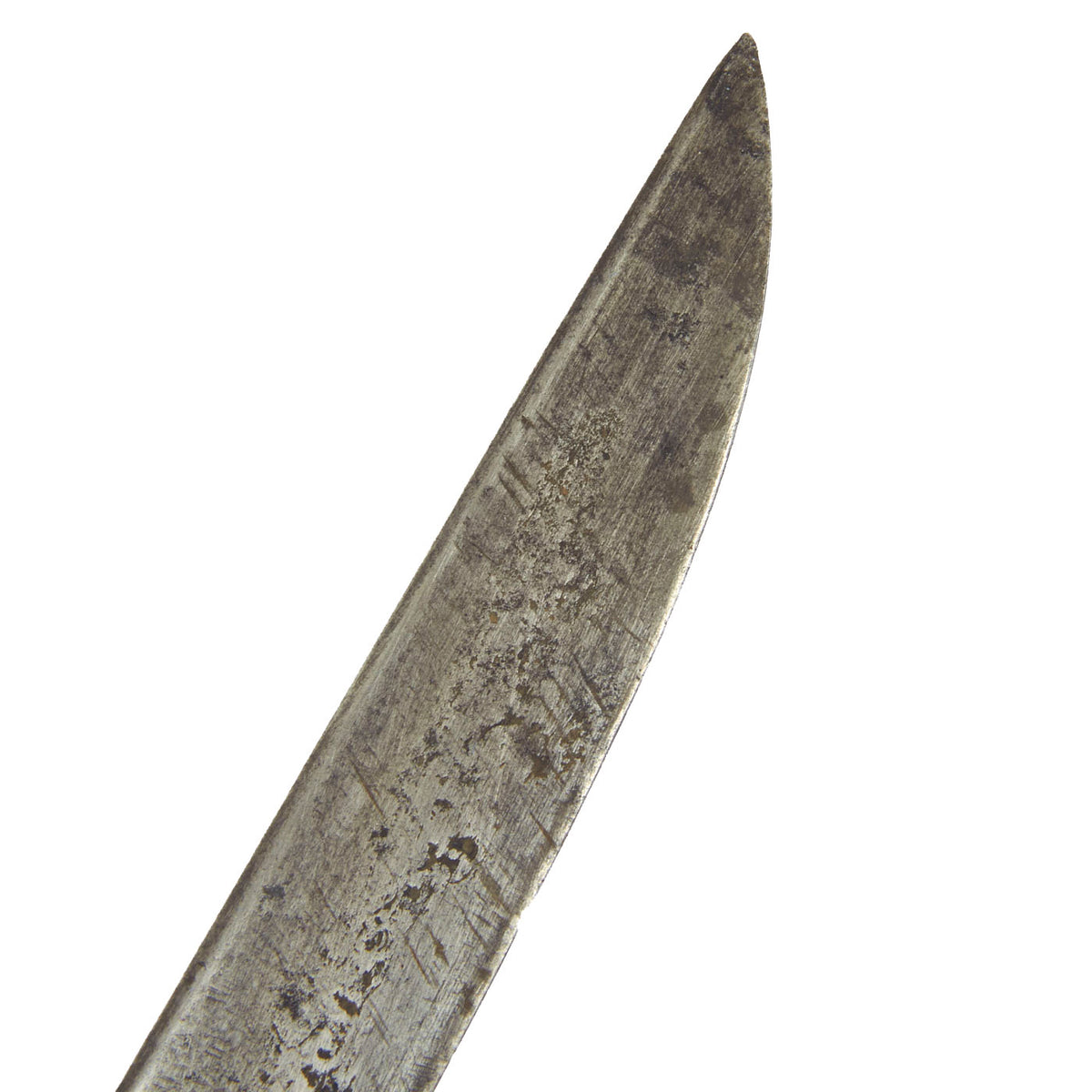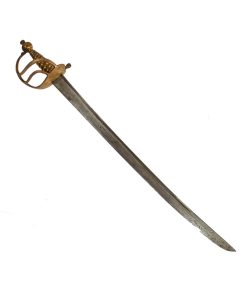Original British Seven Years War Militia Marked P-1751 Hanger Sword by Samuel Harvey Original Items
$ 1.495,00 $ 373,75
Original Item: Only One Available. This is a very nice example of a mid 18th Century British Infantryman’s “Hanger Sidearm” or Short sword. It is typical of the type used during both the French & Indian War, as well as the American Revolutionary War and Seven Years War.
The brass three bar guard is engraved 1 / 43 M=HUNTINGDON, indicating that it was from the First Company of the 43rd Regiment of Foot, Huntingdon Militia. The blade is slightly curved with a single narrow fuller down each side near the spine, and there is an unmistakable British Military manufacturer mark punched into both sides of the 25″ blade. The markings are a “Running Wolf” with the initials SH on the body, for maker Samuel Harvey, a cutler that looks to have been based on Birmingham in the 18th century. His markings have been seen on other similar militia hangers of the period. Overall condition is very nice with a great look.
Overall length is 30 ½ inches, and it definitely does show age and use, with a great patina.
A lovely example that comes more than ready for further research and display.
Dimensions:
Blade length: 24 3/4”
Overall length: 30 1/2”
Handguard: 4 1/2”L x 5”W
The 43rd Regiment of Foot was raised in 1741. Its first visit to America was in June, 1757 when it arrived off Halifax to participate in the French and Indian War. In September, 1759 it was the center of Gen. Wolfe’s line on the Plains of Abraham before Quebec and won acclaim for its bravery and discipline in that British victory. In July, 1762 it again distinguished itself at the storming of Havana, Cuba. Afterwards, it was stationed in Jamaica, where it remained until March, 1764 when it sailed back to England.
The 43rd of Foot left Portsmouth for America again in June, 1774 as the first of ten regiments sent to bring order to the chaotic situation in Boston, MA. The Light Company of the regiment was one of several engaged at Concord Bridge under the command of the 43rd’s Capt. Walter Laurie. If, as it seems, no actual command to fire was given at Lexington Green earlier in the day, Laurie was the first British soldier to order his troops to fire on Americans. The first three British dead of the Revolution are from the Light Companies under his command. Altogether that day, the 43rd lost Lt. Edward Hull, taken prisoner after being mortally wounded; four enlistedmen killed, five enlistedmen wounded and two captured.
The 43rd was involved in minor actions with the patriots during their siege of Boston. The entire regiment participated in the bloody attack on Bunker Hill and lost two sergeants and 20 enlistedmen killed and three sergeants, two drummers and 77 enlistedmen wounded – very heavy casualties at a time when few regiments could muster the 450 men called for in regulations. Among the 43rd’s losses was Major Roger Spendlove, who was mortally wounded. The unit’s major since February, 1773, he was a 30-year veteran of the regiment. A 57-year-old native of Clive, Shropshire, England, and had been wounded four times previously in its service.
When the British Army left Boston in March, 1776, the regiment moved with it to Halifax. In July, 1776, it landed in New York as part of the Fifth Brigade, participating in the Battles of Long Island, Kip’s Bay and White Plains, as well as the assault on Ft. Washington. The 43rd also was part of an assault on Rhode Island, landing at Weaver’s Bay on December 7. The British forces met only slight opposition there and the 43rd was soon returned to New York. Here there was little major action except for scattered attacks by small groups of Americans on various sentry posts. So little activity seems to have demoralized some of the men as records show the 43rd had two suicides on consecutive days. One man took his life by drowning and the other shot himself because of a connection with a married woman of the regiment.
In August, 1778, the 43rd returned to Rhode Island, driving the militia and regulars from Quaker Hill on the 29th in a fight that cost the regiment 3 killed, 16 wounded and one missing. In his general orders following the battle, the Commander-in-Chief particularly acknowledged “with great applause the spirited exertions of the 43rd under Colonel March.” The unit remained in occupation of the state until being returned to New York on October 25, 1779 and spent the winter at Huntingdon, Long Island.
In March, 1780 Capt. William Thorne led a detachment on a “rebel-catching, house-burning raid” through Hackensack, NJ. The regiment was also engaged in other raids into New Jersey and Connecticut the remainder of the year. On June 9, during a demonstration by the New York garrison into New Jersey, the 43rd’s Lt. William Sherlock was captured in a hen roost, fowl-in-hand, along with about 6 rank and file in Elizabeth Town after having been tempted too far from the picquets by the thought of a chicken dinner. On June 23 the demonstration culminated with the Battle of Springfield and the 43rd returned with the rest of the army later the same night.
On April 30, 1781, the 43rd was one of two regiments sent to Virginia to reinforce Cornwallis, landing at Brandon on the James River on May 26. Nine days after landing the 43rd was engaged at Jamestown Ford, losing two killed and one wounded. At this battle, the 43rd was part of the British force’s left wing and was opposed by troops from the Pennsylvania Line among which was the Second Pennsylvania Regiment, making this event probably the only time during the war that troops from each unit actually fought each other. Later the regiment was besieged with the rest of the British Army at Yorktown, where it sustained casualties of ten killed, 18 wounded and 12 missing. At least one officer, Capt. Duncan Cameron, distinguished himself at the American redoubt the night of October 14. The strength of the regiment at the capitulation on October 19 was 94 rank-and-file, with an additional 168 men sick and wounded. Following the surrender, the Battalion Companies were interned until May, 1783, and were part of the final embarkation for England on November 22.
The 43rd Regiment of Foot was one of the very few British military units to serve on the continent for the entire length of the American Revolution. It was to make yet one more excursion to the former colonies and was part of the British force that unsuccessfully assaulted New Orleans in the War of 1812. Today its heritage is preserved as the 1st Battalion of the British Army’s famed Royal Green Jackets.
Fast Shipping with Professional Packaging
Thanks to our longstanding association with UPS FedEx DHL, and other major international carriers, we are able to provide a range of shipping options. Our warehouse staff is expertly trained and will wrap your products according to our exact and precise specifications. Prior to shipping, your goods will be thoroughly examined and securely secured. We ship to thousands clients each day across multiple countries. This shows how we're dedicated to be the largest retailer on the internet. Warehouses and distribution centres can be located throughout Europe as well as the USA.
Note: Orders with more than one item will be assigned a processing date depending on the item.
Before shipping before shipping, we'll conduct a thorough inspection of the items you have ordered. Today, the majority of orders will be delivered within 48 hours. The delivery time will be between 3-7 days.
Returns
The stock is dynamic and we cannot completely manage it because multiple stakeholders are involved, including our factory and warehouse. So the actual stock may alter at any time. It's possible that you may not receive your order once the order has been made.
Our policy is valid for a period of 30 days. If you don't receive the product within 30 days, we are not able to issue a refund or an exchange.
You can only return an item if it is unused and in the same state as the day you received it. You must have the item in its original packaging.
Related products
Uncategorized
Uncategorized
Uncategorized
Angolan Rebel 1970s era 60mm Inert Display Mortar from Angolan Civil War Original Items
Uncategorized
Armoured Fighting Vehicles of the World: AFVs of World War One (Hardcover Book) New Made Items
Uncategorized
Australian WWII Owen MK1 Machine Carbine SMG Custom Fabricated Replica with Sling Original Items
Uncategorized
Uncategorized
Uncategorized
Uncategorized
Uncategorized
Uncategorized
Uncategorized
Uncategorized
